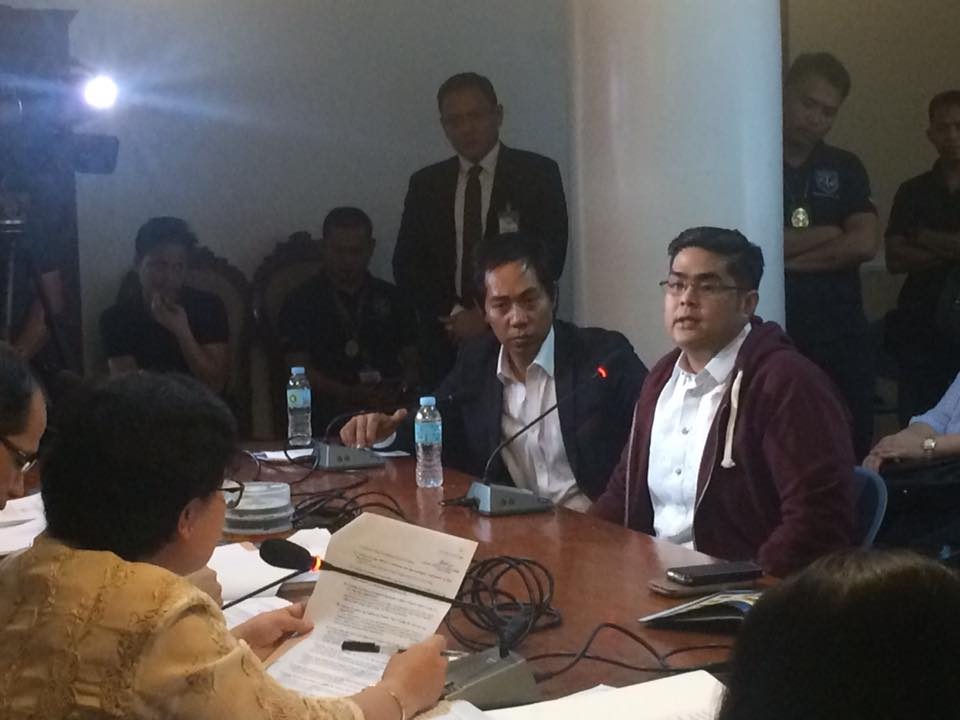SUMMARY
This is AI generated summarization, which may have errors. For context, always refer to the full article.

MANILA, Philippines – The family of slain freshman law student Horacio “Atio” Castillo III downplayed on Monday, January 22, the alleged contradiction between the tell-all affidavit of witness Marc Anthony Ventura and the police medico-legal report.
John Paul Solano said Ventura’s testimony speaks of paddling in the lower extremity, but the police’s medico-legal report points to trauma in the upper extremity as cause of death.
Castillo’s uncle Gerry Castillo dismissed it as another flimsy alibi.
“We’re not stupid here, how can you die, obviously he died, it speaks for itself, they killed him,” Gerry said on Monday.
The Department of Justice (DOJ) conducted a hearing on Monday to clarify some of the statements Ventura said in his affidavit – a sensational confession and his ticket to being a state witness and exempt from suit.
Ventura, in his affidavit, said Castillo was paddled on his legs, specifically “sa pagitan ng ilalim ng puwet at sa itaas ng likod ng tuhod (the part from below his buttocks to above the back of his knee.)
This part of the body is called the lower extremity. Upper extremity includes the arms.
“What is clear from the medical reports is that Atio suffered traumatic physical injuries on the upper extremities only, both upper limbs,” Solano said in his comment opposition submitted to the DOJ.
The Manila Police District or MPD’s ‘final’ medico-legal report says Castillo’s cause of death was “severe blunt traumatic injuries, both upper limbs.”
MPD releases "final" medico-legal report dated October 3 that says Atio Castillo’s cause of death is severe blunt injuries @rapplerdotcom pic.twitter.com/ZjNYF3qmQq
— Lian Buan (@lianbuan) November 9, 2017
“Do you believe him? If you saw the body of Atio, basically he died of rhabdomyolysis, his muscles were swollen. He died of acute renal failure, secondary to rhabdomyolysis,” said Gerry Castillo, who is also a medical doctor.
MPD’s final medico-legal also said Castillo’s immediate death were traumatic soft tissue injuries from swollen arms.
Although Ventura indeed said Castillo was paddled on his lower extremity, he also said in the affidavit that the first phase of the hazing included punching Castillo on the arms “hanggang tumigas o pumutok ang braso (until his arm muscles hardened or swelled),”
“It’s so obvious, they killed him, from the hazing,” Gerry Castillo said. (READ: The different angles in Atio Castillo’s hazing case)
Confident of conviction
Castillo’s mother Carmina is confident that his son’s case would result to a conviction of the anti-hazing law, only the second in Philippine history should it occur, from the time the law was enacted in 1995.
“I will have the biggest conviction rate with this case,” Carmina said.
The Castillos’ lawyer Lorna Kapunan said political will would mark the difference in Atio’s case.
One of the last high-profile hazing cases was that of St. Benilde student Guillo Cesar Servando, which was dismissed in May 2016 after the Makati Regional Trial Court (RTC) Branch 53 ruled that the “prosecution failed to allege that the final initiation rites was a prerequisite to the entry/admission of the victim to the Tau Gamma Phi fraternity.”
“What makes this different is political will, the President himself said so that there will be justice for the parents. The DOJ is using all its resources, everybody is given due process here, there is no railroading,” Kapunan said.
Alumni
While Ventura named every single member of Aegis Juris fraternity present in the hazing rites, the Castillo family wants to pin down the alumni who may have had a hand both in the fraternity’s operations and the alleged coverup afterwards.
“May sinabi si Ventura na may instruction na lumayo na kayo, sino nagsabi nun (Ventura said something about instruction to get away, who said that?) of course obviously there is conspiracy to conceal the crime,” Carmina said.
During the hearing, Ventura repeated that fraternity members would sometimes visit their elders at the Pacific Star Building.
“Who owns that law firm? Who is leasing that property, and who is the principal of that law firm?” Gerry Castillo said.
The Pacific Star Building also houses the Divina Law Office the firm of University of Santo Tomas (UST) Law Dean Nilo Divina. The Castillos also filed a murder complaint against Divina.
Divina has denied ever meeting Castillo, and he denied that he is the Aegis Juris ‘Big Brother’ that fratmen refer to. – Rappler.com
Add a comment
How does this make you feel?
There are no comments yet. Add your comment to start the conversation.